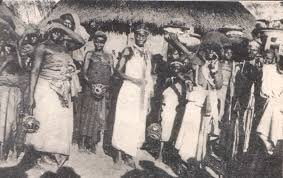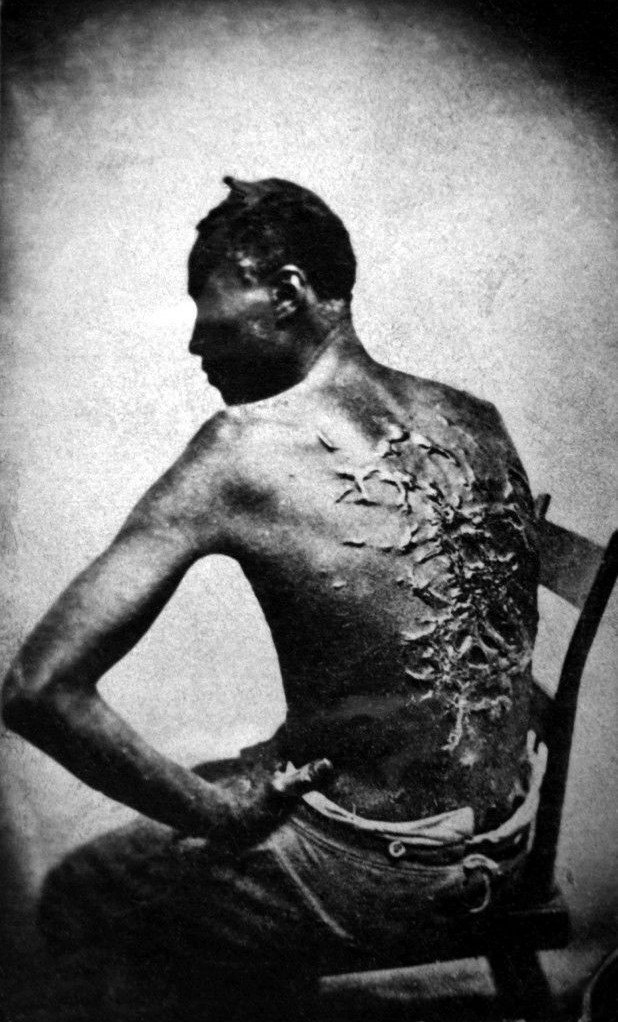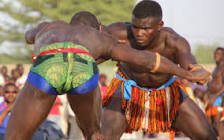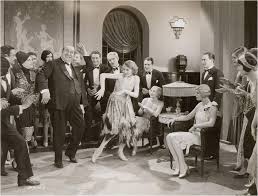HISTORY -- With Nzekwe Gerald Uchenna
NIGERIA DURING THE TRANSATLANTIC SLAVE TRADE (Part 2)
THE EMPIRICAL STUDY OF THE YORUBA PEOPLE, AND HOW YORUBA OBA'S, CHIEFS AND YORUBA ELITES SOLD THEIR FELLOW YORUBAS DURING THE TRANSATLANTIC SLAVE TRADE ERA:

NIGERIA DURING THE TRANSATLANTIC SLAVE TRADE (Part 2)
THE EMPIRICAL STUDY OF THE YORUBA PEOPLE, AND HOW YORUBA OBA'S, CHIEFS AND YORUBA ELITES SOLD THEIR FELLOW YORUBAS DURING THE TRANSATLANTIC SLAVE TRADE ERA:
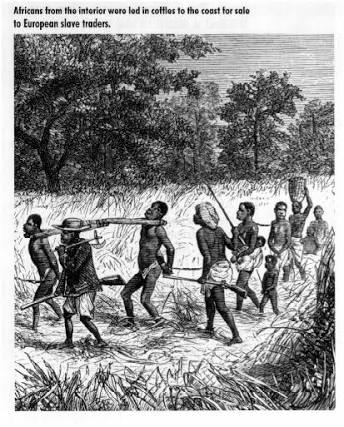
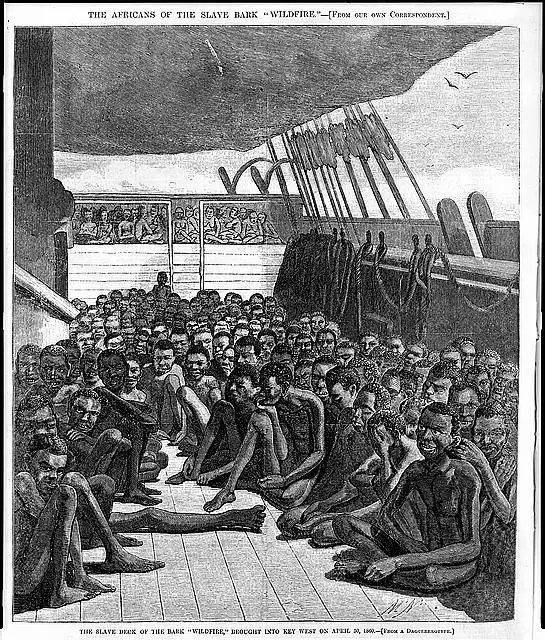
During the 19th century of the Transatlantic slave trade, Yoruba territory was known as the Slave Coast.
Uncounted numbers of Yoruba men, women and children were sold by their Tribesmen,and were shipped bounded in Chains at the Neck, Leg & Hands,to Portugal, Britain, Americas etc
Uncounted numbers of Yoruba men, women and children were sold by their Tribesmen,and were shipped bounded in Chains at the Neck, Leg & Hands,to Portugal, Britain, Americas etc
The demand for African slaves during the slave trade was fuelled by the availability of a supply chain which involved African rulers, tradesmen/women who made fortunes out of selling their own people.
Unfortunately, so many Yoruba Elites got Wealthy through this Nefarious Trade.
Unfortunately, so many Yoruba Elites got Wealthy through this Nefarious Trade.
This thread will look at :
* The Origin of the Yoruba People ,
* The life style/Culture/traditional Worships of the Yorubas before the White man visiting,
*The Involvement of Some Yorubas in the Transatlantic Slave Trade Business,
* The Origin of the Yoruba People ,
* The life style/Culture/traditional Worships of the Yorubas before the White man visiting,
*The Involvement of Some Yorubas in the Transatlantic Slave Trade Business,
* The Story of Madam Efunroye Tinubu a Yoruba Slave trader and Arms dealer
* The Story of Efunseyitan Aniwura who has over 2000 slaves working in her farms
* The Abolition of Slave Trade and Some Notable Slave Returnees in Nigeria.
So, if you guys are ready,........Let's Go.
* The Story of Efunseyitan Aniwura who has over 2000 slaves working in her farms
* The Abolition of Slave Trade and Some Notable Slave Returnees in Nigeria.
So, if you guys are ready,........Let's Go.
ORIGIN OF THE YORUBAS :
The Yorubas traces their root from Oduduwa.
Oduduwa is regarded as the Creator of the Earth and the Ancestors of all Yorubas.
According to Yoruba Creation Mythology, the Deity (gods) Originally lived in the Sky with only water below them.
The Yorubas traces their root from Oduduwa.
Oduduwa is regarded as the Creator of the Earth and the Ancestors of all Yorubas.
According to Yoruba Creation Mythology, the Deity (gods) Originally lived in the Sky with only water below them.

Olorun, the Sky God, gave to Orishala, the god of Whiteness, a chain, a bit of Earth in a Snail Shell, and a Chicken that has five-toes.
Olorun then told Orishala to go down and create the earth.
Orishala then approached the gate of heaven.
Olorun then told Orishala to go down and create the earth.
Orishala then approached the gate of heaven.
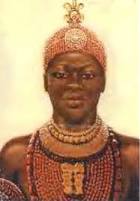
Orishala then saw some deities having a party and he stopped to greet them.
They offered him Palm Wine and he drank too much and fell asleep.
Oduduwa, his younger brother, saw Orishala Sleeping.
He then took the materials and went to the edge of heaven, accompanied by Chameleon.
They offered him Palm Wine and he drank too much and fell asleep.
Oduduwa, his younger brother, saw Orishala Sleeping.
He then took the materials and went to the edge of heaven, accompanied by Chameleon.
Oduduwa then let down the chain and they Climbed down from it.
He then threw the piece of Earth on the water and placed the five-toed chicken upon it.
The chicken began to scratch the Earth with it toe, spreading the earth in all directions.
He then threw the piece of Earth on the water and placed the five-toed chicken upon it.
The chicken began to scratch the Earth with it toe, spreading the earth in all directions.

When the Chicken finished, the Chameleon then tested the firmness of the earth, before Oduduwa then stepped down from heaven.
Another Myth says, Oduduwa came from Mecca, founded Ile Ife and dispatched his sons to establish other Cities, where they reigned as Priest-Kings.
Another Myth says, Oduduwa came from Mecca, founded Ile Ife and dispatched his sons to establish other Cities, where they reigned as Priest-Kings.

Oduduwa's family grew and expanded as one of the largest African Ethnic Groups.
Oduduwa stayed at Ilé-Ifẹ̀, that is why sees Ife as their Ancestral home..
Ife tradition is headed by Ooni of ife
Oduduwa Son,Oromiyan ruled Oyo and his the father of the first Oba of Benin,Eweka.
Oduduwa stayed at Ilé-Ifẹ̀, that is why sees Ife as their Ancestral home..
Ife tradition is headed by Ooni of ife
Oduduwa Son,Oromiyan ruled Oyo and his the father of the first Oba of Benin,Eweka.
THE YORUBA PEOPLE BEFORE THE WHITE-MEN CAME:
The Yoruba lived in organized patrilineal groups that occupied village communities and subsisted on agriculture.
The Yoruba tribes were governed by a hierarchy of chiefs, secondary chiefs and elders.
The Yoruba lived in organized patrilineal groups that occupied village communities and subsisted on agriculture.
The Yoruba tribes were governed by a hierarchy of chiefs, secondary chiefs and elders.

Tribal families held property for
which they did not pay rent or taxes.
The earliest known of
the Yoruba city state is Ilé-Ifẹ̀ and Ijebuland.
The Yoruba loves salutations. And they have many different forms of salutations for :
Eating - Eku Jehun,
Sitting down - Eku Joko,
which they did not pay rent or taxes.
The earliest known of
the Yoruba city state is Ilé-Ifẹ̀ and Ijebuland.
The Yoruba loves salutations. And they have many different forms of salutations for :
Eating - Eku Jehun,
Sitting down - Eku Joko,
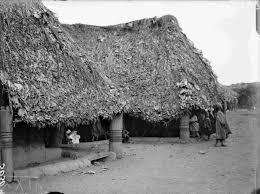
feasting, working, Mourning, Marriage, Riding and walking etc, all require particular ways of greeting that they must add 'EKU' to it.
Within the Yoruba Society, you could find not only culture and religion,but also Hardworking,kind-hearted,Faithful and self-sacrificing people.
Within the Yoruba Society, you could find not only culture and religion,but also Hardworking,kind-hearted,Faithful and self-sacrificing people.
YORUBA LANGUAGE
The Yorubas were bound together by a common language.
The Yoruba language belongs to the Congo-Kordofanian language family.
Yoruba has many dialects, but its speakers can all understand each other.
The Yorubas were bound together by a common language.
The Yoruba language belongs to the Congo-Kordofanian language family.
Yoruba has many dialects, but its speakers can all understand each other.

ANCIENT YORUBAS WRITING LANGUAGE:
Although Ancient Yorubas didn't have a written language, but they Communicated with Symbols.
Tangible Objects like shells, stones, Coal,
Fowl Feathers, Corn, Sticks, Pepper and Powder were used to convey ideas, wishes and feelings.
Although Ancient Yorubas didn't have a written language, but they Communicated with Symbols.
Tangible Objects like shells, stones, Coal,
Fowl Feathers, Corn, Sticks, Pepper and Powder were used to convey ideas, wishes and feelings.

For example:
¶ A Single Shell displayed Or given
away may communicate failure and defiance.
¶ If a Yoruban wished to affirm relationships between himself and a Brother Or Sister, he may
deliver to them two Shell's strung together, face to face.
¶ A Single Shell displayed Or given
away may communicate failure and defiance.
¶ If a Yoruban wished to affirm relationships between himself and a Brother Or Sister, he may
deliver to them two Shell's strung together, face to face.
Similarly,
¶ Two Shell's strung, back to back, represented enmity and separation.
¶ likewise, If the Yoruban wished to have an immediate and friendly meeting with
someone, he would tie a Small feather between two facing shells.
¶ Two Shell's strung, back to back, represented enmity and separation.
¶ likewise, If the Yoruban wished to have an immediate and friendly meeting with
someone, he would tie a Small feather between two facing shells.
YORUBA ANCIENT RELIGIONS:
Religion and Culture were an Obsession to the Yorubas.
The Yorubas had 40 Orisha/deities/idols, some of them constituting deified human beings,
some gods over the natural elements,
some being domestic,Agricultural Or
Craft gods.
Others being Animals,.
Religion and Culture were an Obsession to the Yorubas.
The Yorubas had 40 Orisha/deities/idols, some of them constituting deified human beings,
some gods over the natural elements,
some being domestic,Agricultural Or
Craft gods.
Others being Animals,.
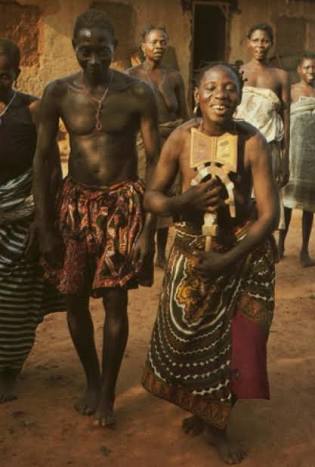
Others being objects of Nature and,
lastly, some being Malignant Spirits.
But, the Yoruba traditional religion holds that there is one supreme being Olorun/Eledumare, who is the source and creator of life (Aye)
Some Yoruba god's:
lastly, some being Malignant Spirits.
But, the Yoruba traditional religion holds that there is one supreme being Olorun/Eledumare, who is the source and creator of life (Aye)
Some Yoruba god's:
° Olorun /Eledumare (Sky God) :
He is the Creator of Aye (life).
Worshipers call on him with prayers Or by pouring water, Local Gin, kola nuts on the ground Or even offering Sacrifices of goat, chicken, fruits and attimes human Sacrifice.
He is the Creator of Aye (life).
Worshipers call on him with prayers Or by pouring water, Local Gin, kola nuts on the ground Or even offering Sacrifices of goat, chicken, fruits and attimes human Sacrifice.

° Eshu (also called Legba by some):
Eshu is the divine messenger who delivers sacrifices to Olorun after they are placed at his shrine.
- Ogun (god of war, the hunt, and metalworking).
n the ancient Yorubaland, Ogun is considered one of the most important deity.
Eshu is the divine messenger who delivers sacrifices to Olorun after they are placed at his shrine.
- Ogun (god of war, the hunt, and metalworking).
n the ancient Yorubaland, Ogun is considered one of the most important deity.

The Yorubas swear to giving truthful testimony, by kissing a machete sacred to the god of Ogun.
° Shango (also spelled Sango and Sagoe) :
He's the deity that creates thunder.
The Yoruba believe that when thunder and lightning strike, Shango has thrown a thunderstone to earth. After a thunderstorm, Yoruba traditional leaders will be searching the ground for thunderstone,..
He's the deity that creates thunder.
The Yoruba believe that when thunder and lightning strike, Shango has thrown a thunderstone to earth. After a thunderstorm, Yoruba traditional leaders will be searching the ground for thunderstone,..
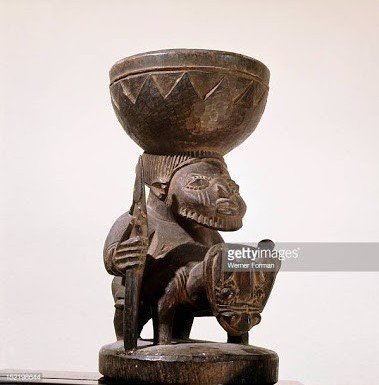
which is believed to have special powers. The stones are housed in shrines dedicated to Shango. Shango has four wives, each representing a river in Yorubaland.
° Ifa - There is a dirty known as ifa.
And so many others, too numerous to mention
And so many others, too numerous to mention
YORUBA MARRIAGE :
Marriages are arranged. A man must negotiate with the girl's father. If he is approved he must bring the family a payment called a bride wealth, paid in three installments. Wedding ceremonies begin at the bride's house after dark.
Marriages are arranged. A man must negotiate with the girl's father. If he is approved he must bring the family a payment called a bride wealth, paid in three installments. Wedding ceremonies begin at the bride's house after dark.

There is a feast to which the groom contributes yams. The bride then is taken to the groom's house. There she is washed from foot to knee with an herbal mixture meant to bring her many children.
For the first eight days after marriage she divides her time between her husband's and her parents' compounds. On the ninth day she moves to her husband's home.
THE ANCIENT YORUBAS FAMILY LIFE
The Yorubas are born into a clan whose members are descended from a common ancestor. Descent is patrilineal—both sons and daughters are born into the clan of their father. Clan members live in a large residential area called a compound.
The Yorubas are born into a clan whose members are descended from a common ancestor. Descent is patrilineal—both sons and daughters are born into the clan of their father. Clan members live in a large residential area called a compound.

The males are born, married, and buried in it. Females live in the compound of their birth until they marry. Then they go to live with their husbands. The eldest male, or Bale, is the head of the compound.
A husband is responsible for settling quarrels within his own family.
A husband is responsible for settling quarrels within his own family.
However, if he is unsuccessful or if an argument involves members of two different families, it is referred to the Bale.
The Yoruba practice polygyny (having more than one wife).
The Yoruba practice polygyny (having more than one wife).
Each wife and her children are considered a sub-family. They have a separate room within the husband's and they share possessions. Each mother cooks for her own children only. A man is expected to treat each wife equally.
RITES OF PASSAGE
A newborn infant is sprinkled with water to make it cry. No word may be spoken until the infant cries. Also, no one younger than the mother should be present at the birth. The infant then is taken to the backyard.
A newborn infant is sprinkled with water to make it cry. No word may be spoken until the infant cries. Also, no one younger than the mother should be present at the birth. The infant then is taken to the backyard.

The umbilical cord is bound tightly with thread and then cut. The placenta is buried in the backyard. On the placenta burial spot, the child is bathed with a loofah sponge and rubbed with palm oil. The child is held by the feet and given three shakes to make it strong and brave.
After a specified number of days, a naming ceremony is held. Relatives attend and bring small amounts of money. Male and female circumcision are usually performed in the first month.
BURIAL :
Burials are performed by the adult men who are not close relatives but belong to the clan of the deceased. The grave is dug in the floor of the room where the deceased lived. After the burial there is a period of feasting.
Burials are performed by the adult men who are not close relatives but belong to the clan of the deceased. The grave is dug in the floor of the room where the deceased lived. After the burial there is a period of feasting.

Many of the rituals associated with burial are intended to insure that the deceased will be reborn again.
YORUBA FOOD :
Some Yoruba foods include :
* Amala - made from elubo (dried yam)
* Iyan - Pounded yam
* Orfoo-foo - Fufu (Cassava)
* Iresi - rice
* Ogi-baba - Pap
* Dodo/Boli - Plantain
* Ewa - Beans
* Agbado - Corn
Some Yoruba foods include :
* Amala - made from elubo (dried yam)
* Iyan - Pounded yam
* Orfoo-foo - Fufu (Cassava)
* Iresi - rice
* Ogi-baba - Pap
* Dodo/Boli - Plantain
* Ewa - Beans
* Agbado - Corn

* Moi-Moi
* Akara - Beans Cake
Etc
YORUBA SOUPS:
Ewedu, Gbegiri, Efo riro, Obe ila (Okra Soup), Eguisi etc
Picture : Efo riro Soup.
* Akara - Beans Cake
Etc
YORUBA SOUPS:
Ewedu, Gbegiri, Efo riro, Obe ila (Okra Soup), Eguisi etc
Picture : Efo riro Soup.

FARMERS :
Almost all Yoruba men then, were farmers, producing food crops for their domestic needs.
Farming is considered men's work.
Wives help their husbands plant yams and harvest corn, beans, cotton.
Women also help their husbands at the market, selling their farm produce.
Almost all Yoruba men then, were farmers, producing food crops for their domestic needs.
Farming is considered men's work.
Wives help their husbands plant yams and harvest corn, beans, cotton.
Women also help their husbands at the market, selling their farm produce.
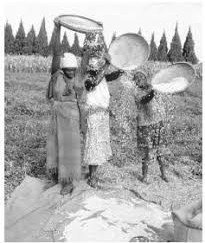
YORUBAS WERE INTO CRAFTS :
Both men and women weave Cloths, using different types of looms. Cloth is woven from wild silk and from locally grown cotton.
Men also do embroidery, particularly on men's gowns and caps, and work as tailors and dressmakers.
Both men and women weave Cloths, using different types of looms. Cloth is woven from wild silk and from locally grown cotton.
Men also do embroidery, particularly on men's gowns and caps, and work as tailors and dressmakers.

Floor mats and mat storage bags are also made by men.
Women are the potters. In addition to palm oil lamps, they make over twenty kinds of pots and dishes for cooking, eating, and carrying and storing liquids.
Woodcarvers, all of whom are men,..
Women are the potters. In addition to palm oil lamps, they make over twenty kinds of pots and dishes for cooking, eating, and carrying and storing liquids.
Woodcarvers, all of whom are men,..
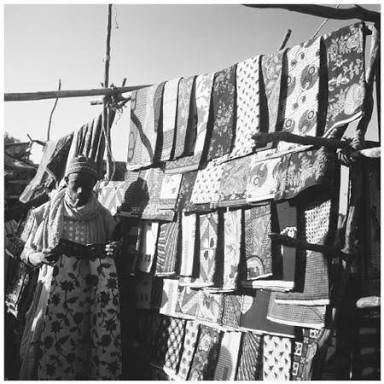
carve masks and figurines as well as mortars, pestles, and bowls. Some Yoruba woodcarvers also work in bone, ivory, and stone. Blacksmiths work both in iron and brass to create both useful and decorative objects.
CULTURAL HERITAGE
The Yoruba tradition includes praise poems, tongue twisters, hundreds of prose narratives and riddles, and thousands of proverbs.
Yoruba songs includes songs of ridicule and praise, as well as lullabies, war songs, and work songs.
The Yoruba tradition includes praise poems, tongue twisters, hundreds of prose narratives and riddles, and thousands of proverbs.
Yoruba songs includes songs of ridicule and praise, as well as lullabies, war songs, and work songs.

These usually follow a "call and response" pattern between a leader and chorus. Rhythm is provided by drums, iron gongs, cymbals, rattles, and hand clapping. Other instruments includer long brass trumpets, ivory trumpets, whistles, stringed instruments, and metallophones.
Perhaps the most interesting musical instrument is the "talking drum." The "talking drum" features an hourglass shape with laces that can be squeezed to tighten the goatskin head, altering the drum's pitch.
CHRISTIAN MISSIONARIES IN YORUBALAND :
In the early 18th Century,.the White reaching out to the Yorubas for Missionary work.
it was through there Christian Religion Missionary work and Trade, that the Whites Penetrated the Yoruba Empire,
In the early 18th Century,.the White reaching out to the Yorubas for Missionary work.
it was through there Christian Religion Missionary work and Trade, that the Whites Penetrated the Yoruba Empire,

When the Yorubas first saw these white-skinned, Missionaries visitors, the Yoruba named them “Oyinbo,” which means “men of the peeled skin.” 

YORUBAS ARE ONE OF THE LARGEST CONTRIBUTORS OF THE TRANSATLANTIC SLAVE TRADE :
In the Olden days, Africans spend more of their time and resources visiting Native Voodoo Priests (Babalawo/Debian), against their on blood brother Or kinsman becaus of Envy, rift Or quarrel.
In the Olden days, Africans spend more of their time and resources visiting Native Voodoo Priests (Babalawo/Debian), against their on blood brother Or kinsman becaus of Envy, rift Or quarrel.

Many Africans were selling off their brothers into Slavery for as little Guns, Gins, Mirrors, Bead etc .
Among all the ethnic Groups in Africa, the Yoruba from West Africa are one of the largest contributors of Slaves, during the Transatlantic Slave Trade.
Among all the ethnic Groups in Africa, the Yoruba from West Africa are one of the largest contributors of Slaves, during the Transatlantic Slave Trade.

The reason why there is a very high representation of Yoruba Ancestral Slaves in American, Europes and Caribbeans, is because their Fellow Yorubas Sold their Ancestors into Slavery during the Transatlantic Slave Trade
WHY SLAVE TRADE THRIVED IN YORUBALAND :
The Yoruba Empire were Situated along the Coastal region (near the seas) so it was easier to ship slaves from their nearby Ports. One of such Slave Port is at Badagry.
The Yoruba Empire were Situated along the Coastal region (near the seas) so it was easier to ship slaves from their nearby Ports. One of such Slave Port is at Badagry.

Yoruba Empire was not just only a Nigerian geographical area then,it extended to parts of Benin Republic and Togo,all located along the Coast.
Although,Every other part of Africa suffered over time, but those nearer to the sea/shipping Ports were more engaged in the Slave Trade.
Although,Every other part of Africa suffered over time, but those nearer to the sea/shipping Ports were more engaged in the Slave Trade.

There were dozens of known African slave traders who sold thousands of Slaves to European slave merchants.
In West Africa,the Traders were known as Caboceers and they lived on the coast.
They are usually appointed by African rulers to deal directly with European slave merchants.
In West Africa,the Traders were known as Caboceers and they lived on the coast.
They are usually appointed by African rulers to deal directly with European slave merchants.

Many, such as the caboceer from the Fante people, John Currantee, or the leader from the Efik people Ephraim Robin John (known to the European traders as King George) were well-known as canny and ruthless dealers. 

Another Known Slave trader from the Yoruba tribe of Nigeria was Madam Tinubu. She was so powerful and influential in the Lagos Oba Politic and the Transatlantic Slave Trade market in Badagry.
Let's look.at her Story.
Let's look.at her Story.
THE GREAT MADAM EFUNYAYO TINUNU :
During 19th Century, Madam Efunroye Tinubu, was the wealthiest woman and Slave Trader in Yorubaland.
Madam Tinubu was not Only a Slave Trader, She was also a King Maker, Arms Dealer, Business Tycoon, Socialite and an Egba Warrior.
During 19th Century, Madam Efunroye Tinubu, was the wealthiest woman and Slave Trader in Yorubaland.
Madam Tinubu was not Only a Slave Trader, She was also a King Maker, Arms Dealer, Business Tycoon, Socialite and an Egba Warrior.

Early Life:
Her real name is Efunporoye Osuntinubu Olumosa, but it is often shortened to Tinubu.
Madam Tinubu was born in the Ojokodo forest area of Egbaland.
Her father's named Olumosa a farmer, While her mother's name is Nijeede a trader.
Her real name is Efunporoye Osuntinubu Olumosa, but it is often shortened to Tinubu.
Madam Tinubu was born in the Ojokodo forest area of Egbaland.
Her father's named Olumosa a farmer, While her mother's name is Nijeede a trader.
Her mother named her Osuntinubu; because she was a child gotten from the goddess pf the Osun river
When she was little, She do follow her mother to Abeokuta from Egbaland when a lot of the villages around were being Killed following the Yoruba wars of 1821.
When she was little, She do follow her mother to Abeokuta from Egbaland when a lot of the villages around were being Killed following the Yoruba wars of 1821.
Madam Tinubu learned commerce from her mother and grandmother who were also successful traders.
She grew up to become a politically significant figure in Nigerian history because of her roles as a powerful female aristocrat and slave trader in pre colonial and colonial Nigeria ..
She grew up to become a politically significant figure in Nigerian history because of her roles as a powerful female aristocrat and slave trader in pre colonial and colonial Nigeria ..
while also being a major figure in Lagos politics during the reigns of Obas Adele, Oluwole, Akitoye and Dosunmu.
Tinubu was married four times in her lifetime.
Tinubu was married four times in her lifetime.
Her first marriage was to an Owu man, and they had 2 sons before her husband died following the family’s migration to the town of Abeokuta in 1830.
As a widow and single mother, she took to business and was successful thanks to her grandmother and mother who were business women.
As a widow and single mother, she took to business and was successful thanks to her grandmother and mother who were business women.
In 1833, Madam Tinubu married for the second time. She married Prince Adele of Lagos who was On exile.
After Prince Adele lost out on the Obaship of Lagos, he decided to tour Abeokuta on a goodwill visit to thank the people for their support.
After Prince Adele lost out on the Obaship of Lagos, he decided to tour Abeokuta on a goodwill visit to thank the people for their support.
It was there he met, got attracted to the Windowed Madam Tinubu,he proposed making her as his wife,and the young widow accepted.
She then moved with her new husband to a place called Agbadarigi (Badagry) in Lagos.
Badagry was traditionally the place of refuge for Lagos monarchs.
She then moved with her new husband to a place called Agbadarigi (Badagry) in Lagos.
Badagry was traditionally the place of refuge for Lagos monarchs.
But, Unfortunately, Madam Tinubu lost her two sons to malaria while at Badagry.
Madam Tinubu arrived at Badagry at a time when the then illegal Transatlantic slave trade was peaking on the eastern Slave Coast.
Madam Tinubu arrived at Badagry at a time when the then illegal Transatlantic slave trade was peaking on the eastern Slave Coast.
She started by using two slaves, to trade between Abeokuta and the Coast,in slaves and other commodities.
Despite her lack of formal education,She expanded her business activities to include Slaves,Arms and ammunition and also established a flourishing trade in tobacco and salt.
Despite her lack of formal education,She expanded her business activities to include Slaves,Arms and ammunition and also established a flourishing trade in tobacco and salt.
QUEEN TO OBA OF LAGOS :
The exiled Oba Adele was still in Badagry when his successor, Oba Idewu, died. Prince Kosoko, Idewu Ojulari's brother, was a major contender for the now vacant throne.
The exiled Oba Adele was still in Badagry when his successor, Oba Idewu, died. Prince Kosoko, Idewu Ojulari's brother, was a major contender for the now vacant throne.
But, Eletu Odibo, the Chief kingmaker, thwarted Kosoko's aspiration and Prince Adele was invited by him to become Oba again.
The new Oba then ruled with his new Queen, Efunroye Tinubu.
As Queen of Lagos,Tinubu used her royal authority to solidify her Slave Trade business empire.
The new Oba then ruled with his new Queen, Efunroye Tinubu.
As Queen of Lagos,Tinubu used her royal authority to solidify her Slave Trade business empire.
She invested her growing income from Slave trade and other retainers, beginning the process of amassing personal followers and expanding her commercial operations.
The enterprising Madam Tinubu was later to expand her trade,..
The enterprising Madam Tinubu was later to expand her trade,..
which brought her into contact with the European slave traders, with whom she dealt as a middle person. She strengthened her position as an intermediary in the trade between the expatriate community and the indigenous population of Lagos on the one and Abeokuta, on the other.
In 1937, Four years after marrying Oba Adele and two years after he became king, Madam Tinubu became a widow again as the Lagos monarch passed away untimely. Her marriage with Oba Adele produced no children, although the king had children from other marriages.
Oba Adele was succeeded as Oba by his Son, Oluwole who Madam Tinubu supported over Kosoko.
Oba Oluwole had regular clashes with Prince Kosoko because he felt he was the true heir to the throne of Lagos.
To curb his excesses, Prince Kosoko was banished from Lagos by Oba Oluwole.
Oba Oluwole had regular clashes with Prince Kosoko because he felt he was the true heir to the throne of Lagos.
To curb his excesses, Prince Kosoko was banished from Lagos by Oba Oluwole.
During Oba Oluwole’s reign,
Madam Efunroye Tinubu married for the third time, to Yesufu Obadina who was the Oba of Lagos, Oluwole's Military Chief.
And with the support of Oba Oluwole, Tinubu and Obadina grew their empire by increasing trade with the Egbas.
Madam Efunroye Tinubu married for the third time, to Yesufu Obadina who was the Oba of Lagos, Oluwole's Military Chief.
And with the support of Oba Oluwole, Tinubu and Obadina grew their empire by increasing trade with the Egbas.
Madam Efunroye Tinubu continued to grow her business and created a monopoly in Slave Trade and Palm Oil as well.
The ammunition she got from selling slaves were used in the Yoruba wars of 1840s and 1850s.
The ammunition she got from selling slaves were used in the Yoruba wars of 1840s and 1850s.
In 1941, Death soon struck again. The Oba of Lagos Oluwole died. This time around Madam Tinubu Supported her brother-in-law Akitoye’s bid to ascend the Lagos throne over Kosoko.
And In return, Oba Akitoye gave her important stores in the choice area of Lagos.
And In return, Oba Akitoye gave her important stores in the choice area of Lagos.
At this time Madam Efunroye Tinubu had reached the peak of her powers. It was said she had 360 slaves of her own.
She also built a might residence for herself at this time to reflect her position in Lagos. At this period Madam Tinubu invested in coconut oil and cotton also.
She also built a might residence for herself at this time to reflect her position in Lagos. At this period Madam Tinubu invested in coconut oil and cotton also.
She was a power broker in deals with foreign nations.
Madam Tinubu was often accused of bending the thrones power to her personal and business advantage. This was evident by her influence in Akintoye’s palace.
Madam Tinubu was often accused of bending the thrones power to her personal and business advantage. This was evident by her influence in Akintoye’s palace.
Following her extensive support for the Oba Oduwole, and Akintoye, she was accused of being the power behind the throne.
But,She was unable to control Oba Akitoye as much as was as people thought.
But,She was unable to control Oba Akitoye as much as was as people thought.
Now, Against the wish of his chiefs and Madam Efunroye Tinubu, Oba Akitoye of Lagos, invited Kosoko back to Lagos, so as to tried and mend fences with him. But instead, the invited Kosoko dislodged Akitoye from the throne.
in 1845, because of Madam Tinubu’s alliance with Akitoye, she and other Akitoye supporters fled to Badagry when Kosoko’s coup became successful and he became Oba.
While on exile, Madam Tinubu used her status as a wealthy woman, to influence economic and political decisions.
While on exile, Madam Tinubu used her status as a wealthy woman, to influence economic and political decisions.
During her exile in Badagry, she tried to rally the Supporters of Oba Akitoye’s together, so as to start series of uprisings against the Oba Kosoko.
In December 1851, the British bombarded Lagos under the guise of wanting to end the
slave trade business in Lagos.
In December 1851, the British bombarded Lagos under the guise of wanting to end the
slave trade business in Lagos.
They then dislodged Kosoko from the throne. They then reinstalled Akitoye as Oba of Lagos, as the British finds Akitoye more easier to work with and control. Despite Oba Akitoye signing a treaty with Britain to outlaw the slave Trade Business,..
Madam Tinubu continued trading in slaves as it was her most lucrative source of business subverting the 1852 treaty.
She also established secret Trades of Slaves for guns with Brazilians and Portuguese traders building herself an army.
She also established secret Trades of Slaves for guns with Brazilians and Portuguese traders building herself an army.
Furthermore, she was awarded a tract of land from Oba Akitoye which now present-day Tinubu Square and Kakawa Street.
In what was termed reckless, she broke more treaties and used the power of the throne for herself. a conflict developed between Tinubu and some slave traders ...
In what was termed reckless, she broke more treaties and used the power of the throne for herself. a conflict developed between Tinubu and some slave traders ...
including Possu, a Kosoko loyalist.
Possu, Ajenia,and other traders tried to instigate an uprising against Akitoye in 1853 because of Madam Tinubu's influence in Lagos.
In the interest of peace, Benjamin Campbell,the British Consul in Lagos, asked Akitoye to exile Madam Tinubu.
Possu, Ajenia,and other traders tried to instigate an uprising against Akitoye in 1853 because of Madam Tinubu's influence in Lagos.
In the interest of peace, Benjamin Campbell,the British Consul in Lagos, asked Akitoye to exile Madam Tinubu.
By 1853, After Oba Akintoye's death, and was succeeded by Prince Dosunmu, Madam Tinubu returned back to Lagos and gave her support to Oba Akitoye's Successor, Prince Dosunmu.
Under Oba Dosunmu’s reign, Madam Tinubu had an army she armed with the guns from the Brazilians ...
Under Oba Dosunmu’s reign, Madam Tinubu had an army she armed with the guns from the Brazilians ...
and Portuguese composed of slaves.
Due to the sheer volume of her army, she sometimes executed orders that could only be taken by a King.
She was seen as the real owner of the throne and her influence grew even more.
This made Oba Dosunmu to be scared of her influence in Lagos.
Due to the sheer volume of her army, she sometimes executed orders that could only be taken by a King.
She was seen as the real owner of the throne and her influence grew even more.
This made Oba Dosunmu to be scared of her influence in Lagos.
A new development was the colonial government's support for the return of repatriated captives (mostly of Yoruba heritage) to settle in Lagos. Many of the returnees, also called Saro, were favored by the British in commerce and soon began dominating legitimate trade in Lagos.
In 1855, when Campbell traveled to England,
Madam Tinubu tried to influence Oba Dosunmu to limit the influence of Slave returnees but he refused to give in to her request consequently she started and led a rebellion against the Brazillian and Sierra Leonean slaves turned ...
Madam Tinubu tried to influence Oba Dosunmu to limit the influence of Slave returnees but he refused to give in to her request consequently she started and led a rebellion against the Brazillian and Sierra Leonean slaves turned ...
immigrants in Lagos, for using their wealth and power against the office of the King and for breaking all the ancient customs of the Land. In this time, Lagos existed only as Lagos Island.
Her outrage displayed a type of nationalism that worried the British masters.
Her outrage displayed a type of nationalism that worried the British masters.
This was because many of the returnees were favoured by British in commerce due to their ability to trade and build,as against most indigenes of Lagos.The reluctance of the British to enter trade with the original Lagosians lead the returnees dominating legitimate trade in Lagos.
consequently,Tinubu was alleged to have played a part in an uprising against the returnees in which her husband, Yesufu Bada, was a major participant.
In February 1856, Madam Tinubu monopoly and control of power in Lagos was broken,when she also challenged the British Consul.
In February 1856, Madam Tinubu monopoly and control of power in Lagos was broken,when she also challenged the British Consul.
Madam Tinubu was not a fan of Mr. Campbell who she believed was interfering in the sovereignty of Lagos and the royal authority by aiding the returnee Slaves.
So, She tried to oust the British Console,but it failed.
So, She tried to oust the British Console,but it failed.
In May 1856, When the British Console, Benjamin Campbell returned,he asked Oba Dosunmu to banish Tinubu.
In May 1856,Tinubu was banished from Lagos to Abeokuta.
EXILE IN ABEOKUTA :
While, In Abeokuta, Tinubu expanded her business activities to include gunpowder and bullets.
In May 1856,Tinubu was banished from Lagos to Abeokuta.
EXILE IN ABEOKUTA :
While, In Abeokuta, Tinubu expanded her business activities to include gunpowder and bullets.
In time her influence began to be felt also in Egba Politics in which she played two important roles; her contribution to the successful defence of Egbaland during the Dahomean invasion of 1863.
In 1865,a fire engulfed the shops of some traders including some of her properties in Abeokuta, however, this doesn’t appear to weakened her.
She became involved in Abeokuta king-making activities as well,S upporting Prince Oyekan over Ademola for the Alake of Egba title in 1879.
She became involved in Abeokuta king-making activities as well,S upporting Prince Oyekan over Ademola for the Alake of Egba title in 1879.
In 1877, during the Alake succession crisis, her chosen candidate was installed. While in Abeokuta, she allegedly opposed colonial policies in Lagos.
In 1864, she was awarded the title of Iyalode (First Lady).
In 1864, she was awarded the title of Iyalode (First Lady).
The conferment of the title of Iyalode placed her in a position of power, which she was denied in Lagos, for, by virtue of it, she not only acquired the constitutional right to participate in Egba affairs but was also accorded honour and esteem in the community.
CLAIMS ABOUT MADAM TINUBU'S REPENTANCE FROM TRANSATLANTIC SLAVE TRADE :
There has been Many publications (notably those that promote black history) that have asserted that Madam Tinubu later became a changed person after learning about the evils of the Transatlantic Slave Trade.
There has been Many publications (notably those that promote black history) that have asserted that Madam Tinubu later became a changed person after learning about the evils of the Transatlantic Slave Trade.
But,an often cited hagiography about Madam Tinubu by Oladipo Yemitan paints a different picture of an unapologetic and profit minded human trafficker.
On one occasion,during her final sojourn in Abeokuta,She was alleged to have Sold a young boy into slavery and was accused of it
On one occasion,during her final sojourn in Abeokuta,She was alleged to have Sold a young boy into slavery and was accused of it
When arraigned before Ogundipe Alatise over the matter, she reportedly explained: 'I have a large house-hold and I must feed them well. I need money to do that, that's why'.
PERSONAL LIFE ;
Madam Efunroye Tinubu had another marriage making it her 4th, with one Alhaji Momoh Bukar, an Arabic scholar.
Momoh Bukar's children from other wives later adopted the Madam Tinubu's name.
Madam Efunroye Tinubu had another marriage making it her 4th, with one Alhaji Momoh Bukar, an Arabic scholar.
Momoh Bukar's children from other wives later adopted the Madam Tinubu's name.
HER DEATH AND LEGACY:
In 1887, Madam Efunroye Tinubu died.
She was buried at Ojokodo Quarters in Abeokuta.
Tinubu Square on Lagos Island, a place previously known as Independence Square, is named after the late Oloye.
Ita Tinubu (Tinubu's precinct or Tinubu Square) ..
In 1887, Madam Efunroye Tinubu died.
She was buried at Ojokodo Quarters in Abeokuta.
Tinubu Square on Lagos Island, a place previously known as Independence Square, is named after the late Oloye.
Ita Tinubu (Tinubu's precinct or Tinubu Square) ..
had long been known by that name before the country's independence, but it was renamed Independence Square by the leaders of the First Republic.
Likewise a Female Hostel in University of Lagos is named after her.
Likewise a Female Hostel in University of Lagos is named after her.
EFUNSEYITAN ANIWURA (1790s - 1874)
Another Powerful Woman that traded with the Europeans Slavers was Madam 'Efunseyitan Aniwura.
She was involved in trading with Europeans, taking goods and slaves from the hinterland,
to the coast and bringing imported goods, ..
Another Powerful Woman that traded with the Europeans Slavers was Madam 'Efunseyitan Aniwura.
She was involved in trading with Europeans, taking goods and slaves from the hinterland,
to the coast and bringing imported goods, ..

especially arms and
ammunition, back to the hinterland.
Story has it that she has Over 2000 Slaves working on her own personal farms.
Efunsetan Aniwura was a very Wealthy Woman and a very Close Friend of Madam Efunroye Tinubu.
ammunition, back to the hinterland.
Story has it that she has Over 2000 Slaves working on her own personal farms.
Efunsetan Aniwura was a very Wealthy Woman and a very Close Friend of Madam Efunroye Tinubu.
PERSONAL LIFE :
Efunseyitan Aniwura was Born in Abeokuta in the 1790s.
She was a migrant from Egba in present day Ogun State.
Her father's name was Ogunrin, who was a warlord from Ikija, Egba Land.
while her mother is from ile Ife, she was a business woman.
Efunseyitan Aniwura was Born in Abeokuta in the 1790s.
She was a migrant from Egba in present day Ogun State.
Her father's name was Ogunrin, who was a warlord from Ikija, Egba Land.
while her mother is from ile Ife, she was a business woman.
Efunseyitan married multiple times, but Only had a child (a Daughter), whom Efunseyitan Aniwura lost during child birth.
RISE AND FALL :
Efunseyitan Aniwura's business speciality was in arms and ammunition, and she has her own Strong Army.
RISE AND FALL :
Efunseyitan Aniwura's business speciality was in arms and ammunition, and she has her own Strong Army.
She has 2000 slaves and multiple farmlands. She is also into export of Agricultural produce to Porto-Novo, Badagry and Ikorodu.Her major line were in Tobacco and slave trading business.
She also manufactured a local cream Product, Kijipa, that was exported to America and Europe.
She also manufactured a local cream Product, Kijipa, that was exported to America and Europe.
By 1870s, Efunsetan was the richest person in the whole of Yorubaland
In 1867, Efunsetan Aniwura was made Iyalode of Ibadan. Making her the second
Iyalode of Ibadan, taking over from Iyalode Subola, 1850-1867.
In 1867, Efunsetan Aniwura was made Iyalode of Ibadan. Making her the second
Iyalode of Ibadan, taking over from Iyalode Subola, 1850-1867.
EFUNSEYITAN ANIWURA WICKEDNESS TO HER SLAVES :
Efunsetan Aniwura's childless affected Psychologically, because she had no one to inherit her wealth.
Also, at that time, having a successor was seen as a major determinant of affluence.
And because she has None,
Efunsetan Aniwura's childless affected Psychologically, because she had no one to inherit her wealth.
Also, at that time, having a successor was seen as a major determinant of affluence.
And because she has None,
she became depressed, making her to become excessively wicked, Evil and terrorising those under her Charge.
It was said that, she whipped and starved her slaves.
She also created rules that ensured that no slave in her household Should have Sex.
It was said that, she whipped and starved her slaves.
She also created rules that ensured that no slave in her household Should have Sex.
It was said that, her aggressions were mostly targeted towards women, because she
was childless after losing her only child, she would kill any of her
female slaves that became pregnant and any male slave that got her Pregnant Or proposed love.
was childless after losing her only child, she would kill any of her
female slaves that became pregnant and any male slave that got her Pregnant Or proposed love.
She was said to have Ordered the decapitation of 28 and 13 male and female slaves respectively.
There was a Particular issue of One of her female workers who broke the law by getting pregnant.
Efunsetan Aniwura didn't think twice and she ordered that the slave lady be Executed.
There was a Particular issue of One of her female workers who broke the law by getting pregnant.
Efunsetan Aniwura didn't think twice and she ordered that the slave lady be Executed.
This act brought her into direct confrontation with the chiefs in Ibadan.
Due to her excessive behaviour, Efunsetan was Eventually found guilty of the contempt by the council of chiefs, the traditional court in Ibadan
back in the day,but she refused the punishment of self-exile.
Due to her excessive behaviour, Efunsetan was Eventually found guilty of the contempt by the council of chiefs, the traditional court in Ibadan
back in the day,but she refused the punishment of self-exile.
SPIRITUAL POWER:
It was said that, Efunsetan Aniwura also Possesses Spiritual Prowess, Black Magic, Witchcraft, Voodoo etc
It was said that, Efunsetan Aniwura also Possesses Spiritual Prowess, Black Magic, Witchcraft, Voodoo etc
EFUNSEYITAN CONFLICT WITH AARE ONA KAKANFO LATOOSA :
Efunseyitan do lend Arms, Ammunition and sometimes her Slave Warriors to the Ibadan Military, headed by Aare Latoosa.
Efunseyitan does contribute to discussions regarding issues of Ibadan war s and peace,..
Efunseyitan do lend Arms, Ammunition and sometimes her Slave Warriors to the Ibadan Military, headed by Aare Latoosa.
Efunseyitan does contribute to discussions regarding issues of Ibadan war s and peace,..
due to her important position as an arms dealer, and thus had an influence in
politics.
Aare Ona Kakanfo
Latoosa (also spelt Latosa) was a powerful general, warrior and warload who fought in the Kiriji wars.
politics.
Aare Ona Kakanfo
Latoosa (also spelt Latosa) was a powerful general, warrior and warload who fought in the Kiriji wars.
He frequently borrowed arms from Efunsetan and in 1874, he was late in paying the debit he owed her causing Efunsetan to cease her
usual support. As a result Latoosa set out on a War without as much arms as he expected, when he returned he had a bone to pick with Efunsetan.
usual support. As a result Latoosa set out on a War without as much arms as he expected, when he returned he had a bone to pick with Efunsetan.
On May 1, 1874, Efunseyitan was deposed of her position as Iyalode by Aare Latoosa, for politically motivated allegations against her.
The next Iyalode of Ibadan was Iyalode Iyaola (1874-1893).
The next Iyalode of Ibadan was Iyalode Iyaola (1874-1893).
Meanwhile, Efunseyitan Aniwura adopted as a Son the Child of One of her direct niece, and she name she named the Child Kumuyilo.
EFUNSEYITAN'S ANIWURA'S DEATH :
Efunseyitan Aniwura's authority, Influence in Ibadan Politics and opposition to the political views of the Ibadan community head, Aare Ona Kakanfo Latoosa, led him to plot to execute her.
The first account of her death, was that :
Efunseyitan Aniwura's authority, Influence in Ibadan Politics and opposition to the political views of the Ibadan community head, Aare Ona Kakanfo Latoosa, led him to plot to execute her.
The first account of her death, was that :
in 1874, she committed suicide by drinking hemlock when the Latoosa's men came to her house and told her she had been summoned by the Chiefs..
The second is that,
In 1874, Latoosa paid Efunseyitan's adopted Son, Kumuyilo, to betray her and murder her.
Kumuyilo then hired
two of Efunsetan's slaves, who bashed Efunsetan’s head while she was asleep.
In 1874, Latoosa paid Efunseyitan's adopted Son, Kumuyilo, to betray her and murder her.
Kumuyilo then hired
two of Efunsetan's slaves, who bashed Efunsetan’s head while she was asleep.
After her murder, Latoosa then installed Kumiyilo as head of Efunsetan’s household.
However, the family protested and insisted on an investigation into Efunsetan'",s Mysterious death.
Latoosa later bowed to pressure from Egba and Ibadan Chiefs to investigate Efunseyitan's murder
However, the family protested and insisted on an investigation into Efunsetan'",s Mysterious death.
Latoosa later bowed to pressure from Egba and Ibadan Chiefs to investigate Efunseyitan's murder
Kumiyilo was summoned and interrogated.
Kumiyilo then indicted 3 of Latoosa’s close aides in the
murder.
At the End, Kumiyilo was deposed as the head of Efunsetan family.
While, the actual murderers were executed.
Kumiyilo then indicted 3 of Latoosa’s close aides in the
murder.
At the End, Kumiyilo was deposed as the head of Efunsetan family.
While, the actual murderers were executed.
Legacy:
Efunseyitan Aniwura's statue is placed at the center of challenge roundabout, a major point within the city of Ibadan.
Efunseyitan Aniwura's statue is placed at the center of challenge roundabout, a major point within the city of Ibadan.
ABOLITION THE SLAVE TRADE :
In 1807, Britain banned slave trade.
In 1865 the United States abolished it.too
In 1888, Brazil was the last to ban Slave Trade in the Caribbean, marking the end of the barbarism inflicted on men, women and children of colour and their descendants
In 1807, Britain banned slave trade.
In 1865 the United States abolished it.too
In 1888, Brazil was the last to ban Slave Trade in the Caribbean, marking the end of the barbarism inflicted on men, women and children of colour and their descendants

AFRICANS WERE AGAINST THE BAN ON SLAVE TRADE:
There were protests by West African Chiefs and Slave traders after the abolition of slave trade.
According to Nigerian author Tunde Obadina: “When Britain abolished the slave trade in 1807,
There were protests by West African Chiefs and Slave traders after the abolition of slave trade.
According to Nigerian author Tunde Obadina: “When Britain abolished the slave trade in 1807,
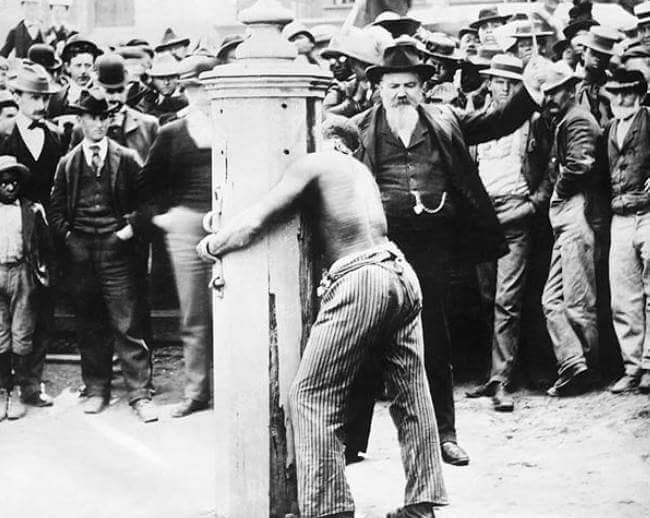
it not only had to contend with opposition from white slavers but also from African rulers who had become accustomed to wealth gained from selling slaves or from taxes collected on slaves passed through their domain.
“
“

African slave-trading classes were greatly distressed by the news that legislators sitting in Parliament in London had decided to end their source of livelihood. But for as long as there was demand from the Americas for slaves, the lucrative business continued,” he added. 

Most of these Slave traders were able to communicate in a number of European and African languages. The African slave traders were skilled in using to their advantage the rivalries between the French, the English and the Dutch to get the best prices for their slaves. 

Often they demanded (and received) ‘gifts’ or ‘custom fees’, known in some quarters as ‘dashee’, from the Europeans.
Most of these traders continued selling slaves despite the ban while others used the slaves to work on plantations in Africa.
Most of these traders continued selling slaves despite the ban while others used the slaves to work on plantations in Africa.

SLAVES RETURNING BACK TO LAGOS ;
After the abolishment of the slave trade, a good percentage of Yoruba slaves returned to Africa.
Many were able to make it back to either Nigeria Or Sierra Leon.
These returnee slaves can easily be identified by their foreign masters last names.
After the abolishment of the slave trade, a good percentage of Yoruba slaves returned to Africa.
Many were able to make it back to either Nigeria Or Sierra Leon.
These returnee slaves can easily be identified by their foreign masters last names.

An example of these returnee families includes the likes of Bishop Ajayi Crowther Family, The Davies Family, Fernadez Family, Desmond Elliot family etc
These returnee families settled mainly in Lagos due to its European Occupying base, and Job Opportunity.
These returnee families settled mainly in Lagos due to its European Occupying base, and Job Opportunity.
Although, Some Yoruba ex-slaves remained behind in Sierra Leone till date, and many still bear Yoruba first Or middle name, in addition to their English Or Portuguese ex-maters names.
YORUBA SLAVES THAT WERE SOLD BUT RETURNED BACK TO LAGOS :
1. FUNMILAYO RANSOM KUTE FATHER, DANIEL OLUMEYUWA THOMAS :
Chief Mrs Funmilayo Ransome-Kuti's father was a returnee slaves.
Francis Abigail Olufunmilayo Thomas was born on 25 October 1900, in Abeokuta.
1. FUNMILAYO RANSOM KUTE FATHER, DANIEL OLUMEYUWA THOMAS :
Chief Mrs Funmilayo Ransome-Kuti's father was a returnee slaves.
Francis Abigail Olufunmilayo Thomas was born on 25 October 1900, in Abeokuta.

Her father's name is Chief Daniel Olumeyuwa Thomas, While are mother's name was Madam Lucretia Phyllis Omoyeni Adeosolu, She is from the Jibolu-Taiwo family.
Madam Funmilayo's father, Daniel is a Saro Slave Returnee.
Madam Funmilayo's father, Daniel is a Saro Slave Returnee.
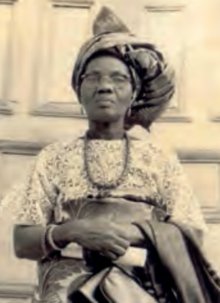
It was when Madam Funmilayo got Married that She adopted the name 'Ransom-Kute'.
She is the mother of Fela Anikulapo Kuti.
She is the mother of Fela Anikulapo Kuti.

2. JOHN NOTTIDGE:
John was the English name given to him by his Slave master.
"Nottidge returned to Lagos and entered government service. When Lagos became a British colony, he became its first jailer."
John was the English name given to him by his Slave master.
"Nottidge returned to Lagos and entered government service. When Lagos became a British colony, he became its first jailer."
3. JAMES GOODING:
"Gooding became an important figure in Lagos in the 1850's and 1860's. Vice-president of the Sierra Leonian Court in 1855, he was later president of the African Commercial Association, started in Lagos in 1863,..
"Gooding became an important figure in Lagos in the 1850's and 1860's. Vice-president of the Sierra Leonian Court in 1855, he was later president of the African Commercial Association, started in Lagos in 1863,..
and composed of emigrants of Ibadan, Ijebu, Egba and Ijesha origins who wanted to mediate in the Ijaye War."
4. JOHN TURNER:
"Turner was an Egba, captured as a boy, sold tot a slave trader, and subsequently liberated at Sierra Leone. He was said to have been closely related to prominent chiefs in Abeokuta. He returned to Lagos in 1853 and soon became a prosperous trader,..
"Turner was an Egba, captured as a boy, sold tot a slave trader, and subsequently liberated at Sierra Leone. He was said to have been closely related to prominent chiefs in Abeokuta. He returned to Lagos in 1853 and soon became a prosperous trader,..
serving on the emigrant court during the consular period, when he also acted as a surveyor oft lands and lots for the Oba, in addition to farming his revenues. On behalf of the Lagos government he was sent to Ejirin ...
Market to negotiate with the Ijebu, with whom he was also said to have had lineal connections. After the burning of the market he settled in Abeokuta, disclaiming BRITISH jurisdiction over him, and ther he continued trading.
The End ....
Sources : NGU Library Collection, Wikipedia, MENY Journals, Ayomide O. Tayo, Oladipo Yemitan, Jean Headlight Kopytoffist, S. G. Pinnock, Nigeria History Archive
#Nzekwe Gerald Uchenna (NGU)
#MovementForTheEmancipationOfNigerianYouths(MENY)
Sources : NGU Library Collection, Wikipedia, MENY Journals, Ayomide O. Tayo, Oladipo Yemitan, Jean Headlight Kopytoffist, S. G. Pinnock, Nigeria History Archive
#Nzekwe Gerald Uchenna (NGU)
#MovementForTheEmancipationOfNigerianYouths(MENY)
• • •
Missing some Tweet in this thread? You can try to
force a refresh




